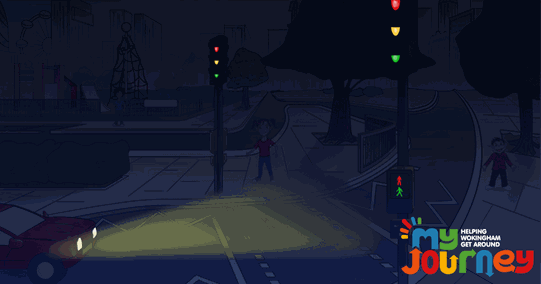Road Safety Support

Be Bright Be Seen
We need to be visible to keep us safe and to let other road users know that we are there.
Being seen is very important for our safety. Many serious accidents happen because drivers do not see other road users until it is too late and twice as many collisions happen with pedestrians in November when the hour goes back, compared to October.
Always wear or carry something bright that will help us to be seen more easily during the day, and at night.
By day...
During the day always wear clothes with bright colours. Fluorescent material (high vis) is even better as it helps us to really stand out and be seen during the day. This material also helps us to be seen in the evening before it is dark.
By night...
Fluorescent material (high-vis) does not work in the dark! We need to wear something reflective so we can be seen when car headlights are shining towards us. Even a small patch of reflective material can help drivers to see us from very far away.
Things to remember!
FLUORESCENT MATERIAL (Hi-vis)– is effective outside during daytime because it reacts to the ultra-violet rays in sunlight. It could be a stripe on your jacket, patches on your bag or an armband.
REFLECTIVE MATERIAL – works in the dark because the special surface reflects light (street lights, car headlights etc.) and is often in stripes on high-vis accessories or taggos.
Safer walking and crossing the road

Online road safety resources for primary and secondary age, including films and games and interactive activities available on DfT Think! website to help teach your child how to cross the road safely.
Visit the Dft Think! website to teach your child about wearing high visibility and reflective clothing while out walking or cycling. Our “Time to Shine” campaign using high-vis rocks with a bingo game is offered to primary schools for weekly loan over the winter months.
Teaching aids available on loan for nurseries/pre-schools include zebra crossing mat, Street Feet road safety training kit (with road layout, signs and tabards), related books and games.
Louis Taylor road safety TiE shows using magic, humour and puppetry run over 4 weeks annually in schools for KS1 and KS2 age children including Safer Steps show for Year 3 and Road Rangers show for nursery/pre-school age.
Safer Steps interactive online storybook resource for Year 3 pupils to support practical pedestrian training with parents. Our new 30 minute Safer Steps show (with Louis Taylor) runs in the autumn term and complements this resource that Year 3 pupils will have access to via their school.
Scooter Safety
Scooters should NOT be used on the road. Motorists will not be expecting to see them among traffic, and because they are so small (especially when ridden by children) they are difficult to see. Their small wheels can easily become stuck in drain covers or pot holes bringing the rider to an abrupt halt, and quite likely throwing them to the ground, in front of vehicles. Scooters should not be used on narrow or crowded pavements, or where they will cause inconvenience, fear or danger to pedestrians, especially elderly or disabled ones. To avoid collisions with innocent people, scooter riders need to keep away from areas where they are likely to come into conflict with pedestrians. A shopper walking out of a store will not expect to be confronted by someone speeding past on a scooter. When crossing the road, dismount a scooter and always use the green cross code.
E-Scooters
Rental e-scooters are currently being trialled in certain areas across England and the Government is not expected to make a decision on whether or not to permit the use of privately-owned e-scooters on public roads until after these trials are complete. Read more here.
E-Scooters: What you need to know
The Wokingham Community Safety Partnership, which includes Thames Valley Police and the Council, are urging schools to remind parents and children of the law around e-scooters. Schools should also be aware that if children are arriving at school on an e-scooter they may not have travelled there legally.
Did you know it’s illegal to ride a privately owned electric scooter (e-scooter) in public? You cannot use a privately owned e-scooter on the road, pavement or in a public space. If you do then you risk receiving a large fine, points on your driving licence and your e-scooter could be seized. Privately owned e-scooters can only be used on private land, with the permission of the landowner. This is because e-scooters are classed as motor vehicles in law. So, in theory, this means that you need an MOT, road tax and insurance to use one, however it isn’t currently possible to register e-scooters in this way. See the e-scooter leaflet under Related Downloads to learn more.
Child Car Seats
Children must be appropriately restrained when travelling in a car. For information and tips on how to choose a child car seat, the law and safety standards go to Child Seat Safety's website.
A child car seat clinic runs once a year in Wokingham Borough with specialists to offer checks and advice.
The Booster Boy campaign aims to raise awareness of the need to use booster seats in cars for children under the height of 135cm.
- Good Egg website - find out about how they are raising awareness of common child seat fitting errors, and how to rectify them to improve in-car child safety
- Watch the YouTube video on child car seat safety - which demonstrates ‘common faults’ with the way child seats are fitted including loose or twisted harnesses, padded clothing, ‘buckle crunch’ (where the adult belt rests on the child seat) and incorrect seat belt routing and how easy it is to rectify these
For further information and advice on safe walking and cycling for children visit:
Walking safety tips for children
If you would like any further information about any of these topics please contact us.

